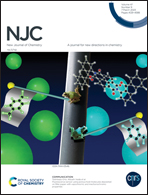A one-pot synthesis of pyridinium-based ionic porous organic polymers for efficient CO2 catalytic conversion†
Abstract
Porous organic polymers (POPs) have been regarded as promising recyclable catalysts for improving the efficiency of CO2 and epoxide cycloaddition due to their diverse catalytic functionality, abundant active sites and good chemical stability. Nevertheless, the need for co-catalysts and metals, the harsh reaction conditions and the complicated preparation methods have greatly limited the wide application of POPs. Herein, we demonstrated the synthesis of one type of pyridinium-based ionic POP named TE-POPs through the one-pot method for use as efficient heterogeneous catalysts for CO2 cycloaddition. The results indicated that the TE-POPs with high thermal stability and excellent chemical stability exhibited the highest CO2 adsorption capacity (32.3 cm3 g−1 at 298 K) among all the reported vinylene-linked POP materials. Importantly, under the optimized conditions of 90 °C, 0.1 MPa CO2 for 20 h, the TE-POPs with multiple active sites could efficiently catalyze the CO2 and epichlorohydrin to chloropropylene carbonate with a yield of 96% without the presence of any co-catalysts or metals. Furthermore, it displayed a wide substrate scope of different epoxides and excellent recyclability, which made it a promising heterogeneous catalyst for the CO2 cycloaddition reaction.



 Please wait while we load your content...
Please wait while we load your content...